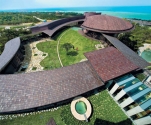Confronting Water Shortages Globally

We continue to publish chapters from the book “Sustainable Architecture in Japan: The Continuing Challenge 1900–2010 & Beyond “, published to coincide with the 110th anniversary of Nikken Sekkei. In the previous issues of our magazine (“Green Buildings”, № 2–4, 2013), we brought to your attention the chapters, which deal with modern methods of the most optimal using of light, heat and wind for creation of comfortable working and living environment. Now let’s focus on water, how to use it the most economical way and thus promote energy efficiency.
GLOBAL WATER SHORTAGES
Reducing greenhouse gas emissions to curb global warming is a serious undertaking that the entire world must take part in. However, there are indications that water shortages pose a greater threat than global warming. At present, two billion people, nearly a third of the world’s population, have inadequate water supplies, and it is estimated that this figure will double by 2025. Water shortages resemble global warming in that they affect the entire world. Unlike global warming, however, water shortages require local solutions.
Consider the following: the Japanese use about 300 liters of water per person, per day, whereas Mongolians use just a few liters per person, per day. By bathing less frequently, the Japanese could easily reduce their per person water consumption by dozens of liters per day, but this would do nothing to improve the water situation in Mongolia. On the other hand, bathing less frequently would also reduce CO2 emissions that result from heating water, which would contribute to the global effort to curb CO2 emissions and, as a result, would benefit Mongolia and the rest of the world.
How should designers of low-carbon cities and sustainable architecture deal with water? Fundamentally, they should preserve local water cycles and should manage water resources to maintain a healthy balance between water supply and demand. First, designers should balance the amount of locally-consumed water with the amount of water that is obtainable from rain, groundwater, and other natural sources. Should deficits emerge despite their best efforts, they should compensate for these deficits by implementing water supply systems.
Urban regions that rely on water supply and sewage systems should avoid polluting their groundwater sources and should conserve water in the same way they conserve electricity and natural gas. The rainwater, groundwater, and other natural water supplies that cycle through cities can be divided into three use categories: consumption water, heat source water, and landscaping water.
Natural water supplies should not be used exclusively as consumption water – they should be used to create comfortable spaces in sustainable buildings and in attractive urban landscapes. Rainwater and groundwater can be collected in underground pits and used as consumption water in flush toilets. By pumping the same water through a heat pump system, it can be used as heat source water in heating and cooling systems. Where groundwater temperature is stable, groundwater can be used as heat source water in radiant cooling systems and, after that, It can be diverted into onsite ponds or streams and used as landscaping water. To take advantage of the evaporative cooling phenomenon, which can mitigate heat island effects, natural water can be circulated in landscapes or pooled in water basins where air currents circulate. A comprehensive design approach that uses natural water in architecture and landscaping is an effective way to create sustainable architecture and attractive, low-carbon cities.
Full content of this issue you can read here
The full version of the article can be read in our printed issue, also you can subscribe to the web-version of the magazine
 Materials provided by Nikken Sekkei
Materials provided by Nikken Sekkei
Text: Kazuhiro Otaka


